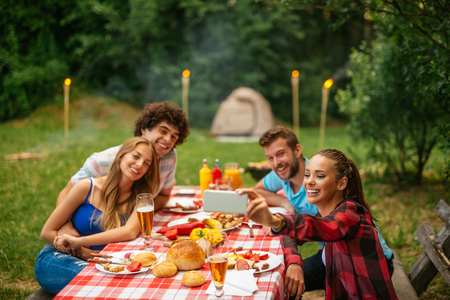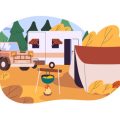1. Choosing the Right Location for Your Camp Kitchen
Setting up the perfect camp kitchen starts with picking the right spot. A good location makes cooking easier, safer, and more enjoyable. Here are some simple tips to help you choose a great place for your outdoor kitchen while following Leave No Trace principles.
Pick a Flat and Level Surface
Look for a flat, stable area where your tables, stove, and gear won’t wobble or tip over. Avoid slopes or uneven ground that could make cooking difficult or dangerous.
Stay Close, But Not Too Close
You want your kitchen to be close enough to your tent for convenience but far enough away (at least 200 feet) to avoid attracting wildlife to your sleeping area. This also helps keep food smells contained in one spot.
Avoid Windy and Exposed Areas
Try to find a spot with natural windbreaks like trees or bushes. Wind can blow out your stove flame or send paper plates flying. But don’t set up directly under trees with dead branches that might fall.
Follow Leave No Trace Principles
Stick to established campsites whenever possible. Don’t clear vegetation just to make space for your kitchen. After your trip, leave the area looking just like you found it—or better.
Camp Kitchen Location Checklist
| What to Look For | Why It Matters |
|---|---|
| Flat and level ground | Makes cooking safe and prevents spills |
| At least 200 feet from sleeping area | Reduces risk of attracting animals near tents |
| Sheltered from wind | Keeps flames steady and makes setup easier |
| Away from dry brush or flammable areas | Reduces fire risk when using stoves or grills |
| No need to disturb nature | Keeps the environment healthy and undamaged |
Pro Tip:
If youre camping in bear country, make sure your kitchen is located near a bear hang or bear-proof storage container so you can stash your food safely when youre done cooking.
Coming Up Next:
Now that youve picked the perfect spot, its time to think about what gear youll need to create a functional and organized camp kitchen.
2. Essential Gear and Equipment Checklist
Setting up the perfect camp kitchen starts with bringing the right gear. Whether youre cooking for two or feeding a hungry group, having dependable equipment can make outdoor cooking easy and enjoyable. Here’s a breakdown of must-have items to pack before you head into the wild.
🔥 Camp Stove
A reliable camp stove is the heart of any outdoor kitchen. Choose one based on your group size and cooking style:
| Type | Best For | Pros | Cons |
|---|---|---|---|
| Two-Burner Propane Stove | Families & Groups | Even heat, cook multiple dishes | Bulkier to transport |
| Single-Burner Backpacking Stove | Solo or minimalist campers | Compact, lightweight | Limited cooking capacity |
| Portable Grill Combo | Grilling enthusiasts | Doubles as grill & stove | Uses more fuel, heavier |
🧊 Cooler or Portable Fridge
You’ll need something to keep perishables fresh. Depending on how long you’re staying out, choose between a high-performance cooler or a portable electric fridge (if you have a power source).
Cooler Tips:
- Use block ice instead of cubes—it melts slower.
- Pre-chill your cooler at home before packing.
- Keep it in the shade and open it only when necessary.
🔪 Prep Table & Cooking Surface
A sturdy prep table gives you space to chop veggies, assemble meals, and keep things organized. Some tables come with built-in sinks or wind guards for stoves—handy extras that can elevate your setup.
Look for features like:
- Adjustable legs for uneven ground
- Shelving or hooks for utensils and ingredients
- Weather-resistant materials for durability
🍴 Kitchen Utensils & Cookware
Your camp kitchen should include the essentials without going overboard. Heres a quick checklist to help pack smart:
| Item | Description |
|---|---|
| Pots & Pans (non-stick recommended) | Choose sizes based on group size; nesting sets save space. |
| Cooking Utensils (spatula, tongs, ladle) | Heat-resistant tools are best for open-flame cooking. |
| Cutting Board & Sharp Knife | A durable surface and a sharp blade make food prep easier. |
| Dishes, Bowls & Cutlery | BPA-free plastic or stainless steel options are durable and easy to clean. |
| Coffee Maker or French Press (optional) | If youre a coffee lover, this can be a morning game-changer. |
🧼 Cleaning Supplies
No one likes doing dishes at camp, but having the right supplies makes it quicker and more sanitary:
- Biodegradable soap and sponge/scrubber
- Two wash tubs: one for soapy water, one for rinsing
- A drying rack or towel for air-drying dishes
- A trash bag and sealable bin for food scraps and waste
Pro Tip:
Create a “kitchen tote” that keeps all your cooking gear organized in one place. That way, setup and takedown are fast wherever you go.
The right gear makes all the difference when building your outdoor kitchen. With these essentials packed, you’ll be ready to cook up delicious meals no matter where you set up camp.
![]()
3. Smart Food Storage and Organization Tips
Keeping your camp kitchen clean, organized, and wildlife-safe is a big part of having a smooth outdoor cooking experience. Whether youre car camping at a national park or setting up deep in the backcountry, knowing how to store your food properly can save you from spoiled meals and unexpected animal visitors.
Keep Wildlife Out
First and foremost, protecting your food from wildlife is crucial. Bears, raccoons, squirrels, and even ants will sniff out anything edible. Use bear-proof containers where required, especially in national parks or bear country. For other areas, airtight bins or coolers with secure latches work well.
Top Wildlife-Safe Storage Options
| Storage Method | Best For | Pros | Cons |
|---|---|---|---|
| Bear Canister | Backcountry camping in bear country | Highly secure, required in many parks | Bulky and heavy |
| Bear Bag (hung) | Lightweight backpacking trips | Portable and light | Takes time to set up properly |
| Airtight Plastic Bins | Car camping or basecamps | Organized and stackable | Not animal-proof if left unattended |
| Cooler with Locking Lid | Short trips with perishable food | Keeps food cold & somewhat secure | Lid may pop open if not latched well |
Prevent Spoilage with Proper Cooling
If youre bringing perishable items like meat, dairy, or fresh produce, youll need a reliable cooler system. Pack your cooler with block ice instead of cubes for longer-lasting cold. Use frozen water bottles to double as ice packs and drinking water later on.
Quick Cooler Tips:
- Pre-chill: Cool your food and drinks before placing them in the cooler.
- Layer smart: Place meats at the bottom to keep them colder and avoid leaks.
- Avoid opening often: Open only when necessary to maintain internal temperature.
- Separate coolers: Use one for food and one for drinks to reduce frequent access to perishables.
Stay Organized with Labels and Bins
A clutter-free camp kitchen makes meal prep easier and faster. Use stackable bins or clear totes to group similar items—think cooking gear, dry foods, snacks, and utensils. Label everything clearly using waterproof tape or chalk markers so you know exactly where things are.
Suggested Bin Setup:
| Bin Label | Contents |
|---|---|
| Dry Goods | Pasta, rice, canned goods, flour, sugar, seasonings |
| Cooking Gear | Pots, pans, cutting board, utensils, spatula, stove fuel |
| Beverage Station | Coffee setup, tea bags, drink mixes, mugs, thermos |
| Smores & Snacks | Graham crackers, marshmallows, chocolate bars, trail mix |
A well-organized camp kitchen keeps everyone happier and mealtime stress-free. With smart storage strategies like these in place, you’ll spend less time searching for supplies and more time enjoying your outdoor adventure.
4. Efficient Cooking and Cleanup Techniques
When youre out in the wild, having an efficient cooking and cleanup system is key to a successful camp kitchen. Whether youre camping for the weekend or going on a week-long adventure, keeping things simple, clean, and eco-friendly will save you time and energy.
Smart Cooking Methods for the Outdoors
Cooking outdoors doesnt mean you have to sacrifice good meals. Here are a few popular and easy-to-manage methods that work great in almost any camp setup:
Popular Camp Cooking Methods
| Method | Best For | Pros | Cons |
|---|---|---|---|
| Camp Stove | Quick meals, boiling water | Reliable heat, easy to control | Needs fuel, extra gear to carry |
| Open Fire Cooking | Grilling, roasting, Dutch oven meals | No need for stove or fuel, adds smoky flavor | Takes time to build fire, harder to control temperature |
| Charcoal Grill | Burgers, veggies, skewers | Great flavor and even heat | Heavy and slower setup/cleanup |
Go-To One-Pot Meals for Easy Cooking
Simplify your cooking by planning one-pot meals. These dishes minimize prep time and make cleanup a breeze. Here are some tasty ideas:
- Campfire Chili: Ground beef or turkey, beans, tomatoes, and seasoning all simmered together.
- Sausage & Veggie Skillet: Slice up sausages with peppers, onions, and potatoes cooked in one pan.
- Pasta Primavera: Pasta cooked with seasonal veggies and a bit of olive oil or sauce.
- Breakfast Hash: Eggs, diced potatoes, leftover meats or veggies all cooked in one skillet.
Eco-Friendly Cleanup: Leave No Trace
A clean campsite is a happy campsite—and its our responsibility to keep nature untouched. Follow these simple steps for environmentally friendly cleanup:
Sustainable Cleanup Tips
- Use biodegradable soap: Always wash dishes at least 200 feet away from lakes and streams.
- Strain food scraps: Use a mesh strainer to catch bits of food before dumping graywater into a cathole (6-8 inches deep).
- Bring reusable dishware: Cut down on trash by using washable plates, cups, and utensils.
- Towel dry and air out: Dry dishes with a clean towel and let them air out completely before packing.
Pro Tip: Set Up a Dishwashing Station
Create an efficient system using three bins: one with hot soapy water for washing, one with clean water for rinsing, and a third optional bin with sanitizing solution (a few drops of bleach per gallon of water). This method keeps everything clean and safe without harming the environment.
A smart approach to cooking and cleaning not only saves time but helps protect the beautiful places we love to explore. With these techniques in your toolkit, youre well on your way to mastering your camp kitchen setup!
5. Creating a Comfortable and Social Cooking Environment
Once your camp kitchen is functional, it’s time to make it feel like the heart of your campsite. A cozy and inviting cooking area not only makes meal prep more enjoyable, but also encourages everyone to gather around, share stories, and relax after a day of outdoor adventure. Here’s how you can turn your setup into a warm and welcoming hangout spot.
Seating: Encourage Conversation and Comfort
Having the right seating arrangement helps create a social vibe. Go for lightweight, foldable chairs that are easy to move around. A small folding table or two can double as prep surfaces during meals and card game spots afterward.
| Type of Seating | Best For | Why It Works |
|---|---|---|
| Camp Chairs with Cup Holders | Relaxing by the fire or kitchen | Comfortable and convenient for drinks/snacks |
| Folding Benches | Larger groups or families | Saves space and seats more people |
| Padded Stools | Compact campsites | Lightweight and easy to pack |
Lighting: Keep the Vibe Going After Dark
The right lighting can make your camp kitchen feel like an outdoor living room. Avoid harsh flashlight beams; instead, aim for soft, ambient light that sets a relaxing tone.
- String Lights: Battery-powered or solar string lights add charm and enough illumination to cook and hang out comfortably.
- Lanterns: Place LED lanterns on tables or hang them from trees or tent poles for even lighting.
- Headlamps (as backups): Handy when you need direct light while chopping or reading recipes.
Shelter: Prepare for Any Weather
A sheltered kitchen means you can keep cooking—even if the weather turns. It also adds a sense of structure and coziness to your setup.
- E-Z Up Canopies: Quick to set up and offer great rain/sun protection over your cooking station.
- Tarp Setups: Lightweight option that can be rigged with paracord between trees. Great for coverage in unpredictable weather.
- Campsite-Specific Shelters: Some campgrounds offer pre-set shelters—use them if available!
Shelter Setup Tips:
- Aim to position your shelter away from prevailing winds.
- If possible, set up near natural windbreaks like bushes or large rocks.
Add Cozy Touches
Add personal elements to make your camp kitchen feel homey:
- A small rug or mat: Keeps feet clean and adds comfort underfoot.
- Battery-powered speaker: Play some tunes while cooking or chilling out.
- Coffee/hot cocoa station: Perfect for early mornings or winding down after dinner.
Your camp kitchen should be more than just a place to cook—it should be where memories are made, where laughs are shared, and where everyone naturally gathers once the sun goes down. With the right seating, lighting, shelter, and personal touches, you’ll create an outdoor space that feels just like home under the stars.


